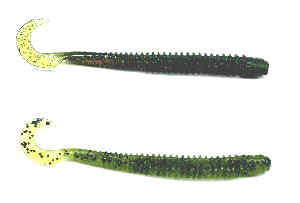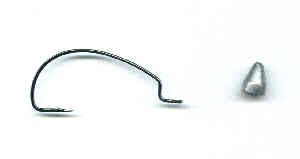|
|
Your "SkinnyRig"...
Don't Leave Home Without It!
by Ken Cook
|
|
I tend to use nicknames and "SkinnyRig"
refers to any of my medium action spinning rods rigged with light line. It's
a lot easier than saying, "6 1/2 foot medium action IM6 spinning rod, Mitchell
SC30 reel and 8 pound Shakespeare mono with a 1/16 ounce weight and a 4"
worm." As Paul Harvey says, "Now for the rest of the story."
I grew up here in Texas and began
my serious bass fishing with "broomsticks and 20 pound line". Qualifying
for my first national championship tournament in 1975, I made the 900 mile trip
to Watts Bar on the Tennessee river and received a rude awakening. Although
we (the Texas group) caught a few fish, we were soundly spanked by the other
guys who were using lighter action rods and twelve pound or lighter line. Lesson
learned, I returned to Texas, rigged a medium action rod with twelve pound line,
1/8 ounce weight and 4" worm or lizard and proceeded to tear the bass up
on the local lakes. As the years progressed and lakes and techniques changed,
I found myself "back to the basics", those heavy rods and line. Heavy
brush and boat dock fishing meant a return to heavy line for flipping jigs and
T-rigging. Long casts with Carolina rigs also required heavy gear to get the
fish out of the cover. The lighter rigs began to collect dust.
Fast forward to the early 90s. The
California guys are "finesse fishing" their deep, clear lakes with
8 pound (or less) line and small baits. I dust off the lighter stuff, buy some
Weenie Worms and experience moderate success in open water scenarios, but it's
back to the big rigs for most conditions.
Another brief fast forward to the
mid 90s. An "immigrant" from Alabama joins the local club and begins
wearing us out with, "AW, not again!", LIGHT tackle. Fishing behind
some of our better fishermen (supposedly to learn the lakes), he's putting some
nice limits in the boat and finishing well in most tourneys. How many times
do you have to slap me with a 2x4? Well...not quite as often as a mule, but
close.
Over the last
three years, going to the SkinnyRig has put several five pound class
fish in the boat for me and, more importantly, put LIMITS in the livewell
when nothing else was working.
Now that the history lesson is over,
many of you are saying, "What's the big deal? It's just a light Texas rig.
We've been doing that all along!" Well...that may be true, but I thought
I'd offer the what, why, when and how of what I've been doing for those who
haven't done it and in hopes there's something the "old hands" may
have overlooked.
| The Bait: Although any small size and type
bait (worm, grub, craw or spider grub) both can and will work, I primarily
use a 4" ringworm or Zoom's dead ringer (which is slightly different).
Visibility of 2 feet or more is best, but I've fished heavy stain and done
well. Zoom's Purple Passion is my #1 color choice, closely followed
by Watermelon Seed. In both cases, I dye the tails chartreuse unless
the fish convince me otherwise. |
Purple Passion
Watermelon Seed
|
|
| The Line: I use 8# mono 80-90%
of the time and 10# mono or 12# braid for special conditions. Although the
12# braid is smaller diameter than the 8# mono, I can achieve a slower fall
with it. I also use it when I believe my chances of getting a fish out of
the cover with 8# mono are nil. This is where the rub (pun intended) is. |
| The Rigging: I Texas rig a Gamagatsu 1/0
light wire hook (58411) and a 1/16 ounce bullet weight, rarely going higher.
Split shotting or some other rigging method could well work, but I haven't
tried them for this application. |
|
| The Tackle: Spinning - a 6 1/2'
medium action graphite rod and a reel that has an excellent drag. What?
Medium action? Yes, the rod must be chosen to have enough backbone to exert
some control on the fish, yet have a soft enough tip to work well with the
reel's drag. |
|
The Conditions:
- Obviously, you can fish a SkinnyRig anytime and do well. Even
when you have a good bite going on standard tackle and baits, it can
be used for the second bait in to a likely spot, to get a hit from a
fish you just missed or just as a change of pace. Conversely, when the
bite gets tough, it's definitely time to dig it out of the rod box and
go to work. I always have mine on deck and ready to go.
- I have found that areas I would normally overlook or make a cursory
pass on while trolling toward a "good spot" are often not
only productive, but the "right place to be". So called nothing
banks with no obvious cover or vegetation will often hold fish susceptable
only to light line techniques.
|
| The Technique: Presentations
and methods of working a bait are numerous as fleas on a dog and I've been
known to use most, if not all of them. My most consistent success is with
dead sticking the bait: letting it settle, sit for a bit, then a brief twitch
to get it moving again. Although I cast, pitch and flip, flipping accounts
for most of my fish. Flipping? Eight pound line? You bet! Grass edges, stumps,
brush piles and boat docks are my primary targets. Although I've done it
and gotten away with it, I rarely place the bait in the middle of a brushpile
as I would with heavy line, but let the bait drift around the edge(s). I've
found that boat dock fish tend to grab this little morsel and head for deep
water with it, rather than running farther under the dock. This sure makes
the job easier but I've sweated a few quality fish out from under docks
too. Breakoffs are going to happen, but a bite and a breakoff are better
than no bite at all! |
Is a SkinnyRig
the best thing since sliced bread? Obviously not, but I feel that it
is an absolutely necessary tool in every Angler's
arsenal!
-30-
copyright © 2000-2025 Ken Cook, all rights reserved

